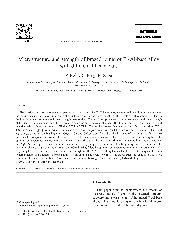摘要
The interfacial microstructure and properties of brazed joints of a Ti3Al-based alloy were investigated in this paper to meet the requirements of the use of Ti3Al-based alloy in the aeronautic and space industries. The effects of different brazing fillers on the interfacial microstructure and shear strength were studied. The relationship between brazing parameters and shear strength of the joints was discussed, and the optimum brazing parameters were obtained. The brazed joints were qualitatively and quantitatively analyzed by means of EPMA, SEM and XRD. The results showed that using a AgCuZn brazing filler, TiCu, Ti(Cu,Al)(2) and Ag[s,s] were formed, the shear strength of the joint was decreased because of the formation of TiCu and Ti(Cu,Al)(2); using a CuP brazing filler, Cu3P, TiCu and Cu[s,s] were formed at the interface of the joint, the former two intermetallic compounds decreased the shear strength. The analysis also indicated that using the TiZrNiCu brazing filler, the optimum parameters were temperature T=1323 K, joining time t=5 min, and the maximum shear strength was 259.6 MPa. For the AgCuZn brazing filler, the optimum parameters were joining temperature T=1073 K, joining time t=5 min, and the maximum shear strength was 165.4 MPa. To the CuP brazing filler, the optimum parameters were joining temperature T=1223 K, joining time t=5 min, and the maximum shear strength is 98.6 MPa. Consulting the results of P. He, J.C. Feng and H. Zhou [Microstructure and strength of brazed joints of Ti3Al-base alloy with NiCrSiB, Mater. Charact., 52(8) (2004) 309-318], relative to the other brazing fillers, TiZrNiCu is the optimum brazing filler for brazing Ti3Al-based alloy.
- 出版日期2005-5
- 单位哈尔滨工业大学
